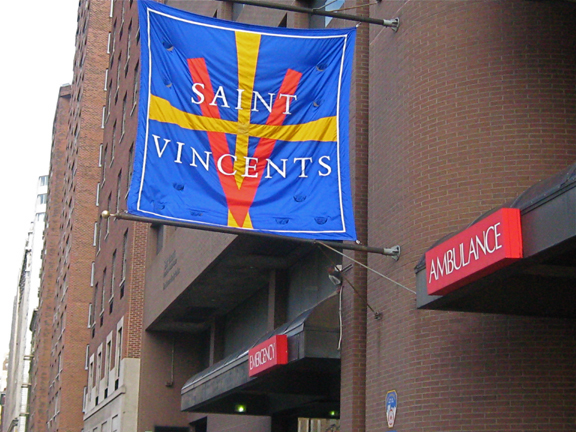06/04/2022 Articles
By Roger Paradiso
“St. Vincent’s soon became ground zero in the city’s AIDS crisis.
St. Vincent’s had the first and largest AIDS ward on the East Coast…in 1984, a year after San Francisco General Hospital’s; by 1986, a third of the hospital’s beds were filled by aids patients” (Andrew Boynton, The New Yorker).

AFTER MORE THAN A CENTURY of serving a growing community, St. Vincent’s closed but the need for a hospital remains. Photo by Maggie Berkvist.
To understand the AIDS crisis we only have to look at the beginning of the Covid crisis. In both cases we had a Republican president. President Reagan’s reaction to AIDS was very similar to President Trump’s reaction to Covid. It was slow and inadequate. But as with Covid, there were brave people who stepped up and met the crisis at the crossroads. These brave individuals realized that running away or hiding and hoping it would go away was not an answer.
I was working on a film for Twentieth Century Fox at their 57th Street offices at the time. They flew in their accountant who was a middle-aged man. Within a few days, he started feeling ill. By the end of the work week, Fox flew him back to Los Angeles. Within days we heard he was in a hospital. Not too soon after that, we heard he was dead. He had AIDS. People were scared. It was like a horror film.
We heard that hospitals were afraid to admit patients. No one had a cure. But many had a story.
“But, despite the outpouring of love from friends and family members as their illnesses dragged on and their prognoses became more dire, both Arthur and Cal seemed to recede, to become more isolated. My visits felt more urgent, an attempt to banish my friends’ loneliness, and at the same time more delicate, an acknowledgment that they were in charge. I never wanted to say goodbye to them, but the only way I could avoid doing that was to stop visiting. So I kept going to St. Vincent’s. And kept saying goodbye. Arthur died in the summer of 1993. Cal died two years later” (Andrew Boynton, The New Yorker).
“Tom Bernarden introduced himself; he said he had lived in the neighborhood for decades. We told him we were interested in the history of the hospital. He told us about his admiration for the Sisters of Charity of New York and why Saint Vincent’s was so important to the LGBT community during the height of the HIV and AIDS crisis. ‘I lost all my friends, all right. You understand? I’m 24 when I move in here. I’m 70 today,’ he told us. When asked about the sisters, he paused for a moment. ‘They were there,’ he said, recalling how many other people turned their backs to a community in need. ‘They were there.’” (Michael O’Loughlin, American Jesuit Review.)
The Sisters of Charity were there to admit the early AIDS patients and to cut through the fear and bigotry. They were there to fulfill their mission of giving medical aid to their Greenwich Village neighbors whether they could pay or not. Sister Karen Helfenstein, SC, who went on to head the AIDS ward, was one of the angels of St. Vincent’s. She remained true to the Sisters of Charity’s mission.
Now, over a decade has passed since St. Vincent’s closed and was replaced by condos. It is the lost St. Vincent’s Hospital now. It is important to remember the legacy of that great hospital.
In retrospect, St. Vincent’s was met at the crossroads by the corporate for-profit hospitals. In April of 2010, our country threw its support behind big medicine, pharma, and healthcare. There was no room in the New York Healthcare system for the Sisters of Charity and their charitable St. Vincent’s Hospital of Greenwich Village.
I spoke to Sister Jane Iannucelli, SC, who was a board member of St. Vincent’s in 2010. She is currently Assistant to the Director of Associates of the Sisters of Charity. She was also one of the angels of St. Vincent’s, and said, “The primary reason the hospital closed is that the State Department of Health did not believe St. Vincent’s was necessary in the area. Were there financial issues? Yes. But state support would have brought the resources necessary to continue the hospital’s service to the West Village and the surrounding areas.”
Sister Jane continued, “As a result of the closing, the Greenwich Village area lost quality medical care provided by skilled and caring doctors, nurses, and staff; they lost access to clinics, community outreach programs for seniors, the homeless, etc.; they lost state-of-the-art behavioral health programs, and more. The surrounding businesses suffered a loss of economic support from the staff. It was several years before Northwell opened its urgent care center to provide much-needed medical care for the community.
“St. Vincent’s Hospital was one of the early missions of the Sisters of Charity. The closing of a ministry that served New Yorkers for 161 years was profoundly felt by every Sister of Charity. It is one of our greatest sorrows, for ourselves and for the community we served.”
